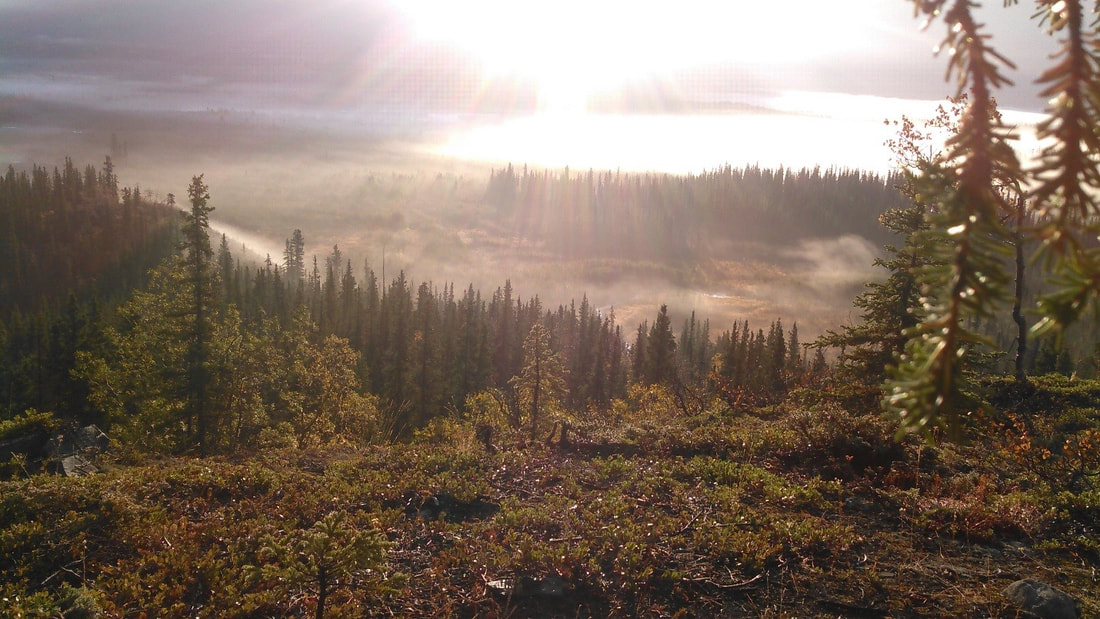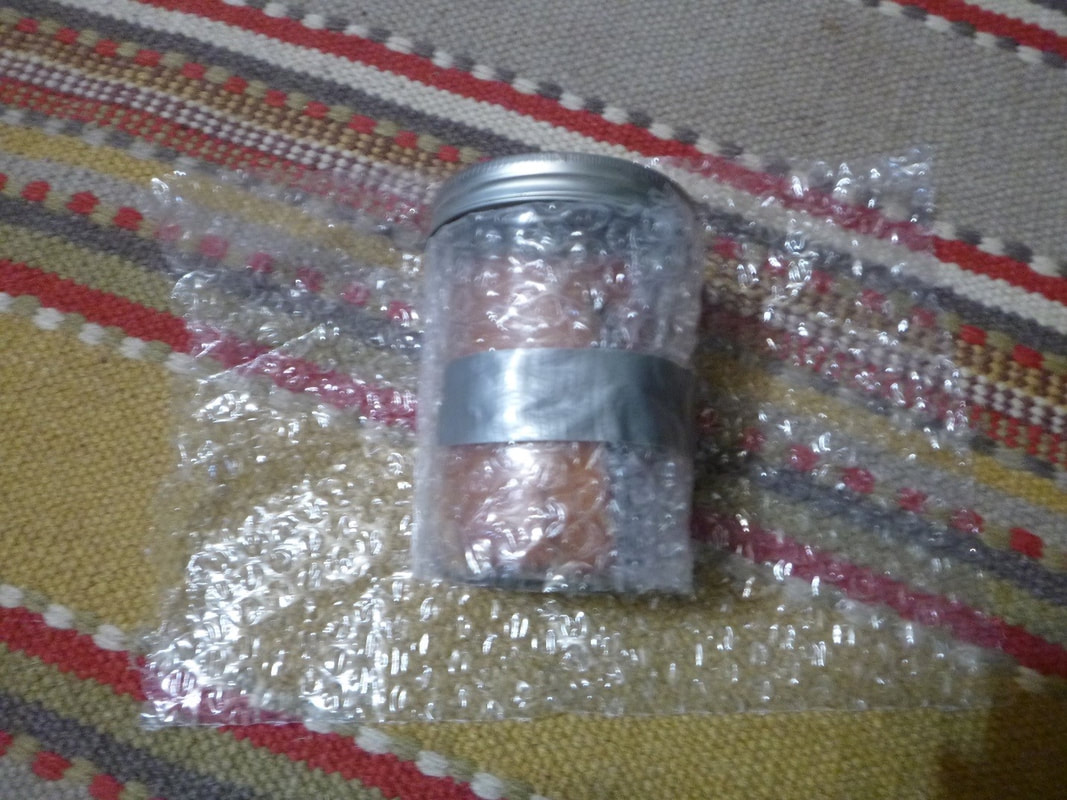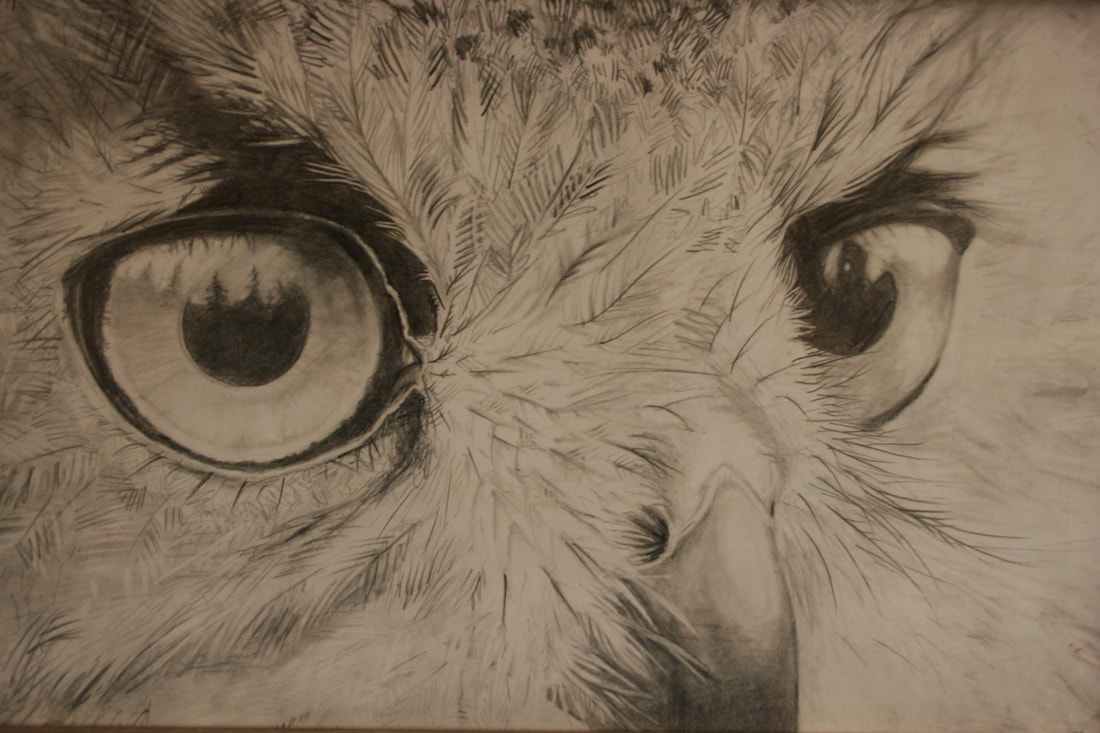|
Copper River Record October 24, 2019 By Robin Mayo Sitting tucked under the wide branches of a spruce tree, we are bundled against the early morning chill and prepared with thermos mugs of coffee, binoculars, and bear spray. This is the perfect spot to see out across the valley at first light. Halfway up the mountainsides, a layer of wispy clouds is sailing upriver at a steady pace. At river level, fog is rising from the ponds and sloughs and drifting slowly downriver. It catches on hillocks and patches of spruce, piling up briefly before being combed into strands and continuing to drift close to the surface. Several hundred yards below us, we harvested a moose in a small meadow in the bend of a slough. We have spent the last three days field dressing, hauling, and hanging the moose on a high pole. All looking forward to watching the gut pile, backbone, and head left behind. A Gray Jay arrived soon after we did, bravely flitting nearby and hauling off any beak-sized tidbit it could pull loose. Surely word has spread among the ravens, magpies, and eagles already. Bears and wolves will not be far behind. Nothing will be wasted. The fog is thickening as a few rays of sun start to reach the ground, well soaked by a night of rain. Soon the valley floor is fully carpeted, only a few ghostly outlines of the tallest spruce trees are visible. I am struck by how slow and subtle yet complete every change in the fog is. You cannot really see movement, but within a few minutes everything is transformed. The air and water are interacting under a complex set of rules: temperature, sun, dew point, breeze, topography. The fog drifts slowly down valley at ground level, but as it lifts to the level of the upriver breeze it is caught and sails with that current. It is okay to be moving in different directions at different levels, I remind myself. It is okay to live within conflicting values, habits, and cultures. My partner eats meat and potatoes, frosted mini wheats with milk. I also like things like asparagus, couscous, and feta cheese. This bothered me at first, but now I smile, privately pleased to eat a whole avocado at one sitting without guilt. The coffee is no longer enough, I have started to think about the four potatoes and one onion that we carried up yesterday evening. The only part of the moose that didn’t get hauled downriver is the ragged end of one of the backstraps. Once the fog is totally gone I’ll go make breakfast. If you cut the potatoes in irregular chunks they won’t stick together as they fry. I’ll wait to add the onion, so the potatoes will have time to get perfectly brown on every side. The meat I will cut across the grain in finger-shaped steaks to roll in seasoned flour then fry hot and fast. An eagle arrives but does not approach the gut pile, watching for ten minutes from the top of a dead spruce. A magpie swoops in to check us out, keen eye locked on our hiding place as he cocks his head to and fro, wondering who we are trying to fool. The fog has gathered itself for another act in the morning drama. It is draped across the valley, some places thick as a blizzard, others thin so the layered silhouettes of ridgelines show. The camera on my phone proves to be totally inept, so I content myself with admiring the way shafts of sun cut between tall spruce, sending rays to the ground. Surely news of this bounty has spread through the valley on the breezes and scavengers are converging, waiting and watching until the smell of our piss fades and they deem it safe to approach. The big bull had an old wound on one hind leg, a thick hard mass of scar tissue all the way around the bone with three puncture wounds that never fully healed, deep pockets of grainy pus ringed with bare skin. At some point a wolf or bear had hold of that leg, but he kicked free. Ten minutes ago the fog looked ready to lift and burn off for good, but the air has gone still now and clumps linger in spite of the direct rays of the sun. The warmth reaches in to our hiding place, welcome on chilled fingers and toes. Ignoring the rumble of my stomach, I wait patiently while pillows soften to shrouds, which dissolve into tufts, which slowly fade. The spell is over. I gather my coffee mug and straighten stiff legs. Walking back to camp, I decide to save half of the onion for stir-fry moose tomorrow. Morning sun cuts through the morning fog at Moose Camp Robin Mayo photo
1 Comment
8/27/2018
By Robin Mayo Ask any Rural Alaskan what they are up to, or how they are doing, and the odds are very good this time of year that their answer will include the word “busy.” Especially as the endless sunlight starts to fade into autumn, we wear our busy-ness as a badge of honor, proof that we are keeping up with the pack in the nonstop race that is summer. And really, how could we not be busy? For many of us, this is full-throttle season at work. Resource managers and –ologists are cramming in as much fieldwork as possible, and anyone with a seasonal or tourism-related job is making every minute count. Hikers, paddlers, climbers, bikers, and backpackers are doing their thing. We are also wedging in building projects and visits from friends and relatives. And on top of all this, we are filling our freezers, pantries, and woodsheds with food and fuel for the winter. I don’t know of a household in the Copper River Valley that doesn’t harvest fish, meat, berries, vegetables, or firewood for the winter ahead. Many of us do all five, which is a tall order. On WISE’s Copper Country Discovery Tour, we visit with Princess Tours guests from around the world, and share our lifestyle with them. One of the things that amazes 100% of these people is how much Alaskans are able to subsist from the land. In most developed parts of the world it is uncommon, and we’ve had many people exclaim, as they nibble on a berry or fresh willow leaf, that this is the first time they have eaten something straight out of the wild. How does it feel? Exhilarating, empowering, and even a little dangerous. I had one guest ask me to please stop encouraging her husband to eat things, she was terrified he would inadvertently ingest an insect, apparently a fate worse than death! For others it triggers fond childhood memories of picking berries or canning preserves with an older relative. For me, subsistence is a fierce pleasure, a love song to the land. I run my fingers along the jars of amber smoked salmon and golden sauerkraut in the pantry, feeling like that ambitious ant in Aesop’s fable. Recently I posted a picture of freshly caught Sockeye on Facebook, which not surprisingly touched off a small debate amongst friends, some of whom were feeling deprived of their yearly fish with the early-season closures. One facebooker stated the opinion that subsistence fish should only be shared with family, and that these special seasons should only be available to those who only live in “real” subsistence villages, which she defined as off the road system. As you can imagine, there was a small tsunami of Copper Basin and other Alaskan residents defending our tradition of sharing with all, and our legacy as a place where subsistence is a truly traditional way of life. It was a wonderful affirmation of how these activities not only fill our bellies, but fill our hearts as well. Busy? Overwhelmed, even? Don’t worry, soon enough the long dark will be here, and there will be time to read that book, clean that house, or knit that sock. For now, I’m thoroughly enjoying the headlong rush of summer into fall, and the feeling of urgency to pick those berries, cut that wood, fill that freezer. Copper River Record October 2017 By Robin Mayo You catch the fish. You clean the fish. You fillet the fish. You brine the fish. You smoke the fish. You pack the jars and run the pressure canner. You unload the canner and line up the jars on the counter, listening for that immensely satisfying “ploink” that means the jar has sealed. You remove the rings, clean the jars, and fill your pantry with bounty. If you are wise and humble, you are now finished. But perhaps you succumb to the sin of pride and post some pictures on facebook. A cooler full of silvery fish. Fillets glistening ruby-orange. A dusky interior shot of the smokehouse. Lines of jars on the counter. And the next thing you know you are inundated with requests from far-off family and friends, wanting a taste. You now have one more step: ship the fish. The two greatest inventions ever for Alaskans who wish to keep in touch with the outside world without breaking the bank are the Alaska Airlines Companion Fare, and the USPS Flat Rate Box. I still remember how excited I was when I discovered that half a dozen pint jars of salmon fit perfectly in a medium flat rate box. It is elegant, efficient, and most importantly, affordable. For $13.60, you can ship anything that fits in the box, anywhere in the US. If it weighs more than two pounds, this is the best bargain around. The heaviest flat rate box I ever received was filled with cool old horseshoes, a lucky shipment for sure. For most situations, I am a “good enough” kind of person. I don’t sweat the details, and strive for simplicity. But for packing jars of smoked salmon for mailing, my motto changes to “Anything worth doing is worth overdoing!” When in doubt, use more tape and bubble wrap. Double up on everything. Did I mention tape and bubble wrap? This is a great way to recycle materials, including bubble wrap, padded envelopes, and anything else cushy. When sending care packages to my wayward daughters, I use fresh socks, purchased by the bundle at Costco. Make Matt Morse happy and use plastic grocery bags instead of sending them to the landfill. You can definitely use some of those Amazon Prime boxes which seem to multiply in the shed. Corrugated cardboard is amazing stuff, as it lends strength and cushioning. It is always good to add something absorbent, in case of disaster. For this I favor back issues of the Copper River Record, so the recipient gets some excellent reading material as well. Start with two medium sized flat rate boxes, available for free at any post office. Fold the bottom of one and tape it well. Line the box with a large plastic bag, such as a kitchen-sized garbage bag. Fold but do not tape the bottom of the second box, and slide it inside the first box, so you now have a double-thick box with a layer of plastic in between. Cut a rectangle of cardboard to fit inside the bottom of the box. This trick works best with wide mouth, straight sided pint mason jars. Narrow mouth pints are a little taller and leave less room for padding, but I sometimes send them anyways because I like to get rid of them. If you use wide-mouth half pints, you can stack them in pairs and send a whole dozen. Make sure each jar has a metal ring, well tightened. First, wrap only the exposed glass sides in small-gauge bubble wrap, or other similar cushy padding. Add another layer which covers the metal ring as well, and folds over to pad the top and bottom of the jar. Secure the whole bundle with plenty of tape. When all the jars are individually wrapped, it’s time to pack the box. Cut strips of corrugated cardboard and put them between the jars, around the edges, and anywhere else they will fit. The jars should be packed snugly, but not too tight, and there should not be any movement if you shake it. Try closing the box before deciding if you need another layer of cardboard on top of the jars. Fold the flaps and tape up the inside box, trim and seal the plastic bag, then tape up the outside box. I’ve never had a flat rate box rejected because it bulges a little, but it will be the strongest if the flaps meet. Address the box, and finish it off with plenty of strong tape around every axis. Save another fifty cents by printing your own shipping label at USPS Click and Ship. I’ve never had a failure when shipping salmon this way. But sometimes you don’t want to ship so many jars, you just need a bombproof way of shipping a jar or two. For this purpose, I make each jar into a padded and leak-proof bundle. Several layers of bubble wrap, covered by a full edition of the Copper River Record, folded and taped so all sides are covered. This is packed in a gallon ziplock bag, then put into a larger carton along with whatever else you are shipping. Make sure the jar can’t shift in the larger box. I like to roll the jars up in sheets of corrugated cardboard which are cut to fit the dimensions of the box. Once again, a redundant layer or two is much preferred over a mess of fish oil and broken glass. One box I am presently packing includes jars of smoked salmon and a laptop computer, so you could say the stakes are high. Is all this hassle worth it? Your relatives will love you, and attempt to reciprocate by sending you ripe peaches, or some other local treat. This will probably be somewhat less successful than your salmon mailing escapade. Your friends will want to visit. Ask them to schedule the trip for fishing season next year, so they can help tend the smokehouse, and listen for the “ploink.” Each jar is individually wrapped
|
Who We AreWISEfriends are several writers connected with Wrangell Institute for Science and Environment, a nonprofit organization located in Alaska's Copper River Valley. Most of these articles originally appeared in our local newspaper, the Copper River Record. Archives
August 2021
Categories
All
|
|
WISE is a
501(c)3 nonprofit organization |
Contact Us |




 RSS Feed
RSS Feed
